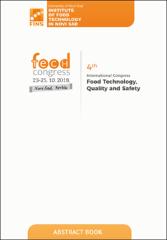| dc.contributor.author | Ljubojević-Pelić, Dragana | |
| dc.contributor.author | Babić, Jelena | |
| dc.contributor.author | Vidaković, Suzana | |
| dc.contributor.author | Pelić, Miloš | |
| dc.contributor.author | Živkov-Baloš, Milica | |
| dc.contributor.author | Milanov, Dubravka | |
| dc.contributor.author | Novakov, Nikolina | |
| dc.contributor.author | Radosavljević, Vladimir | |
| dc.contributor.author | Ćirković, Miroslav | |
| dc.date.accessioned | 2019-11-30T18:37:16Z | |
| dc.date.available | 2019-11-30T18:37:16Z | |
| dc.date.issued | 2018-10 | |
| dc.identifier.isbn | 978-86-7994-054-4 | |
| dc.identifier.uri | https://repo.niv.ns.ac.rs/xmlui/handle/123456789/179 | |
| dc.description.abstract | The Siberian sturgeon (Acipenser baerii) is a fish species that is of great interest
among consumers due to its high sensory properties. This species is also
interesting for fish farmers because of the fact that it is relatively easy to breed, it
grows fast and it is relatively resistant to diseases. Due to its chemical
composition and high presence of polyunsaturated fatty acids fish meat is
generally highly susceptible to lipid degradation and spoilage. It is known that
shelf life of different fish species depends on variety of factors such as their
chemical composition, especially lipid content, season, harvest area and
hygiene during handling and storage. Shelf life and sensory quality parameters
of sturgeon are not well studied and there is only a few data. In spite of
expansion and progress of numerous chemical and microbiological tests in order
to determine the spoilage indicators of fish meat, sensory assessment is still the
most important for determination quality and shelf life of fish and fish products.
The main symptoms of fish spoilage are off-odours and off-flavours and their
development frequently occur simultaneously with the presence of high numbers
of microorganisms. The present study has been carried out to investigate the
sensory quality of chilled sturgeon during 7 days. Whole fish were stored in ice
for a period of 7 days from the time of harvest according to good manufacturing
practice. Descriptive sensory evaluation was performed. The sensory quality of
fresh sturgeon stored in ice was judged by a sensory panel. Sensory
assessments of the whole raw fish and of the cooked fish meat were conducted
at first, third, sixth and seventh day. According to sensory evaluation it can be
concluded that chilled sturgeon is acceptable for use six days after harvesting.
Future experiments are needed for optimization the self-life of sturgeon. Proper
temperature control and handling and hygiene are main tools for extend shelf
life. | en_US |
| dc.description.sponsorship | This paper is a result of the research within the project TR31011 funded by Ministry of Education, Science and Technological Development, Republic of Serbia | en_US |
| dc.language.iso | en | en_US |
| dc.publisher | Institute of Food Technology, Novi Sad (Serbia) | en_US |
| dc.source | Abstracts book, XVIII International congress Feed technology [and] IV International congress 'Food technology, quality and safety', Novi Sad | en |
| dc.subject | fish flesh | en_US |
| dc.subject | storage | en_US |
| dc.subject | shelf life | en_US |
| dc.subject | sensory properties | en_US |
| dc.title | Sensory quality of whole chilled Siberian sturgeon during storage | en_US |
| dc.title.alternative | | en_US |
| dc.type | Article | en_US |

